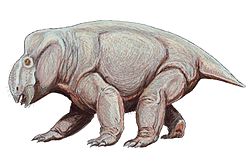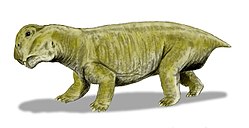| Stahleckeriids Temporal range: Triassic, | |
|---|---|
 | |
| Mounted skeleton of Ischigualastia jenseni | |
| Scientific classification | |
| Kingdom: | Animalia |
| Phylum: | Chordata |
| Clade: | Synapsida |
| Clade: | Therapsida |
| Clade: | † Anomodontia |
| Clade: | † Dicynodontia |
| Clade: | † Kannemeyeriiformes |
| Family: | † Stahleckeriidae Cox, 1965 |
| Subgroups | |
| |
Stahleckeriidae is a family of large dicynodont therapsids whose fossils are known from the Triassic of North America, South America, Asia and Africa. [2]











